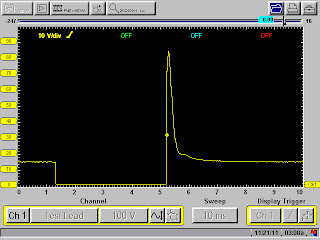This 2001 Nissan Sentra 1.8 liter with 216,173 miles on it rolled into this shop with the MIL on and running rough. The car's owner "diagnosed" it as a bad fuel injector because he had trouble with injectors before. The shop owner called me in to confirm or disprove the customers "driveway diagnosis". I start the car up and indeed it runs rough and has a MIL on. Lets check the code for starters and then roll up the sleeves.
Ok, we got something to go on. I have a P0303 code for cylinder #3 misfire. I am thankful for this because Nissan on the whole usually sets a P0300 code for multiple misfires rather than specific cylinders. Either way we need to confirm if the PCM is telling the truth about which cylinder is misfiring and then find out why it is misfiring. Whenever possible I like to backup what the PCM is telling me. So......
My scanner allows me to do a power balance test. When I select a cylinder I can disable that cylinder and check for contribution. I am looking for rpm drop when the cylinder is killed and I am looking to feel the engine running change as the cylinder is disabled. Here I disable #3 cylinder and the rpm doesn't drop and I do not feel any change in how the vehicle is running. I always try a known good cylinder to compare and check whether my scanner is doing as advertised.
Here I do the same procedure with #1 cylinder. I get a substantial rpm drop and the vehicle runs much differently with #1 cylinder disabled. So, now we know we have a true blue problem with #3 cylinder. What's next?
This Sentra is a California emissions vehicle. It uses two upstream oxygen sensors to monitor fuel control. Oxygen sensor 1 is bank 1 that monitors cylinders #1 and #4. Oxygen sensor 2 is bank 2 that monitors cylinders #2 and #3. Important to know when we look at fuel trims. Just a FYI there was a CA (Clean Air) version that had one Air Fuel ratio sensor upstream instead of two oxygen sensors. Know which emission standard you have when doing testing.
Here are the fuel trims for this vehicle at an idle. Nissan uses what is called Alpha for fuel trim. Basically 0 Alpha is perfect fuel control. Nissan actually displays true 0 Alpha as 100. The Ottotest interprets it a bit differently. But, it serves the purpose. Whenever I have a misfire I always look at fuel trims. They can give you clues to where to go next and zero in on your problem. Remember, my job is to diagnose quickly and accurately. I see nothing here that would tell me that this vehicle suffers from a fuel injector issue. If the fuel injector was plugged or inoperative I would expect to see exaggerated numbers in the positive range as the PCM tries to compensate for the lack of fuel. The exact opposite would happen if the injector was leaking. At this point I am not looking at a fuel related misfire.
Those of you that know how I operate should not be suprised by the next step. Out comes the scope and low amp probe. I need to look at the ignition system. This year utilized 4 COP (Coil on plug) units. First our problem cylinder.
Yeesh! Here we have a textbook example of a shorted coil. The turn on portion of the pattern goes straight up. No turn on oscillations at the beginning of the pattern (more on primary current and turn on oscillations later this month). Let's check a known good cylinder.
Notice the difference. A nice sloping turn on with turn on oscillations at the very beginning of the turn on pattern. This vehicle has a bad COP unit on #3 cylinder. Let's check that #3 injector to satisfy the customer and shop owner.
Looks good to me. Nice pattern with about 4.0ms of on time. A nice injector turn off spike and we know it is not clogged due to the "pintle hump". Let me point out the pintle hump.
This is the pintle hump. This is the actual mechanical closing of the injector viewed through the scope. No pintle hump and typically the injector is clogged or damaged mechanically. Some pintle hump injector patterns will not be so defined. It is something I look at when looking at injector scope patterns. I inform the shop owner to get a quality COP unit and spark plug for #3 cylinder. I also advise to check the rest of the plugs as well.
Just to go the low tech route as well I put my open gap style spark tester on #3 COP unit start the vehicle and we have no spark.











